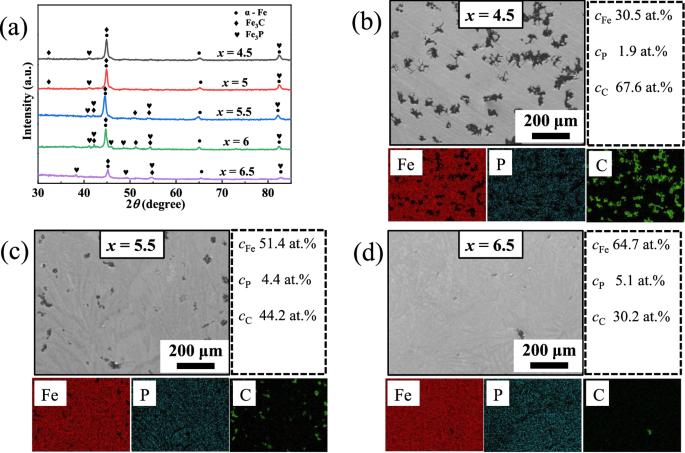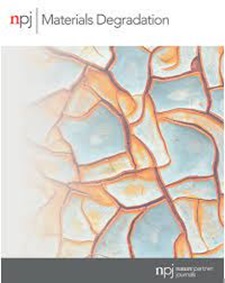Improving the degradation and magnetization performance of FePC amorphous alloys by annealing treatment
IF 6.6
2区 材料科学
Q1 MATERIALS SCIENCE, MULTIDISCIPLINARY
引用次数: 0
Abstract
The Fe80PxC20-x ingots and amorphous ribbons (4.5 ≤ x ≤ 6.5) are arc melted and melt spun respectively. The Rhodamine B degradation performance of as spun and annealed ribbons are investigated with various methods. In present alloys, increasing P content (cP) can inhibit the precipitation of primary α-Fe and graphite phases, and promote the formation of eutectic α-Fe + Fe3C + Fe3P phases in ingots and annealed ribbons. With increasing annealing temperature (Tan), the primary α-Fe grain size of the ribbons with cP = 4.5 at.% increases gradually and that of the ribbons with cP = 6.5 at.% increases firstly and then decreases. The degradation performance and reusability of the ribbons show a similar Tan-dependent behavior, which can be explained by the size effect of the galvanic cells. Meanwhile, the saturation magnetisation Bs and coercivity Hc of the ribbons with cP = 4.5 and 6.5 at.% increase with increasing Tan, showing a near-linear change of the reaction rate constant k against ln (Bs·Hc). This work not only studies the mechanism of improving degradation performance for FePC amorphous alloys by annealing treatment, but also reveals a correlation between degradation performance and magnetization performance of FePC alloys.

通过退火处理改善 FePC 非晶合金的降解和磁化性能
分别采用电弧熔化和熔融纺丝的方法制备了 Fe80PxC20-x 晶锭和非晶带(4.5 ≤ x ≤ 6.5)。通过各种方法研究了纺丝和退火带的罗丹明 B 降解性能。在目前的合金中,增加 P 含量(cP)可抑制原生 α-Fe 和石墨相的析出,促进铸锭和退火带中共晶 α-Fe + Fe3C + Fe3P 相的形成。随着退火温度(Tan)的升高,cP = 4.5 at.%的带材的主α-Fe晶粒尺寸逐渐增大,cP = 6.5 at.%的带材的主α-Fe晶粒尺寸先增大后减小。带材的降解性能和可重复使用性表现出类似的谭氏依赖性,这可以用电化电池的尺寸效应来解释。同时,随着 Tan 值的增加,cP = 4.5 和 6.5 at.% 的带材的饱和磁化率 Bs 和矫顽力 Hc 也在增加,反应速率常数 k 与 ln(Bs-Hc)呈近似线性变化。这项工作不仅研究了退火处理改善 FePC 非晶合金降解性能的机制,还揭示了 FePC 合金降解性能与磁化性能之间的相关性。
本文章由计算机程序翻译,如有差异,请以英文原文为准。
求助全文
约1分钟内获得全文
求助全文
来源期刊

npj Materials Degradation
MATERIALS SCIENCE, MULTIDISCIPLINARY-
CiteScore
7.80
自引率
7.80%
发文量
86
审稿时长
6 weeks
期刊介绍:
npj Materials Degradation considers basic and applied research that explores all aspects of the degradation of metallic and non-metallic materials. The journal broadly defines ‘materials degradation’ as a reduction in the ability of a material to perform its task in-service as a result of environmental exposure.
The journal covers a broad range of topics including but not limited to:
-Degradation of metals, glasses, minerals, polymers, ceramics, cements and composites in natural and engineered environments, as a result of various stimuli
-Computational and experimental studies of degradation mechanisms and kinetics
-Characterization of degradation by traditional and emerging techniques
-New approaches and technologies for enhancing resistance to degradation
-Inspection and monitoring techniques for materials in-service, such as sensing technologies
 求助内容:
求助内容: 应助结果提醒方式:
应助结果提醒方式:


